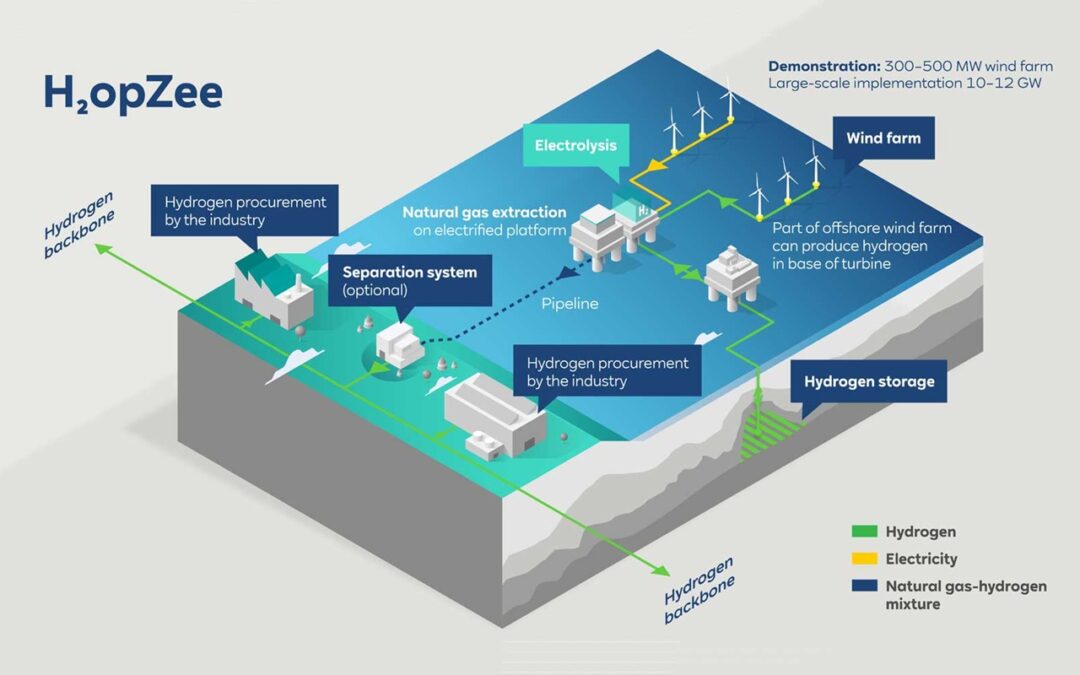The H2opZee consortium comprising RWE and Neptune Energy has awarded technical feasibility study contracts to wind turbine manufacturer Siemens Gamesa and Dutch engineering contractors H2SEA and Enersea to support concept engineering work. The consortium aims to develop the H2opZee offshore green hydrogen project in the North Sea before 2030.
The H2opZee (H2 at sea) project was announced in February this year and the consortium continues to progress its development plans. A joint feasibility study began in June 2022, which is planned to run until the beginning of summer 2023.
The study forms part of the first phase of H2opZee in which various technical concepts and potential development locations are being evaluated in order to assess the optimal solution to generate green hydrogen offshore. Transportation to shore of this green hydrogen will be via pipeline. In the second phase, the project will be implemented. For that phase, a tender methodology has yet to be defined.
The workscopes announced now include offshore platform concept design and engineering, awarded to H2SEA; pipeline concept design, awarded to Enersea; and wind turbine generator systems concept work, awarded to Siemens Gamesa.
The remainder of the technical work will be supported by in-house engineering by RWE and Neptune Energy. The consortium is also working closely with offshore infrastructure owners to evaluate various export options via the existing pipeline network to shore.
Also read: Neptune Energy and RWE to accelerate green hydrogen production at sea
‘Offshore green hydrogen is the next step in the energy transition’
‘Following the very successful roll-out of wind farms producing green electricity in the Dutch North Sea, offshore green hydrogen is the next step in the energy transition and crucial for our domestic future energy supply,’ says Neptune Energy’s Managing Director in the Netherlands, Lex de Groot. ‘It can be produced right here in the North Sea, giving the Netherlands a leading role in providing green energy to North Western Europe, reducing the need for imports. By re-using existing gas infrastructure, the energy transition can be faster, cheaper and cleaner. This infrastructure is technically suitable and already in place, including landing and possible international connections with other countries, such as Norway, Denmark, Germany and the UK.’
He adds: ‘Lessons learned through Neptune’s support for the PosHYdon offshore hydrogen pilot will be applied to H2opZee. The faster we can scale up green hydrogen at sea, the faster industries such as chemical and steel production can become more sustainable.’
Also read: Subsidy for first offshore green hydrogen project
H2opZee
H2opZee aims to build 300 to 500 megawatts (MW) electrolyser capacity far out in the North Sea in order to produce green hydrogen, powered by a dedicated offshore wind park. The hydrogen will then be transported to land via pipeline. The pipeline has a capacity of 10 to 12 gigawatts (GW), and is already suitable for the further roll-out of green hydrogen production to GW scale in the North Sea.
The project is an initiative of TKI Wind op Zee, an initiative supported by the Dutch government that brings people, knowledge and financing together to realise the offshore energy transition in the North Sea. The project is the first of its kind and scale. The knowledge and expertise gained will strengthen the competitive position of Dutch industry, help to draw the value chain of offshore wind and green hydrogen production into the Netherlands, and deliver technology and knowledge that can be exported worldwide.
The project builds upon the AquaVentus and PosHYdon pilots, leveraging key learnings to help de-risk large scale roll-out of offshore green Hydrogen generation.
Picture by RWE.
Also read: Neptune plans to capture CO2 in depleted Dutch North Sea gas fields








